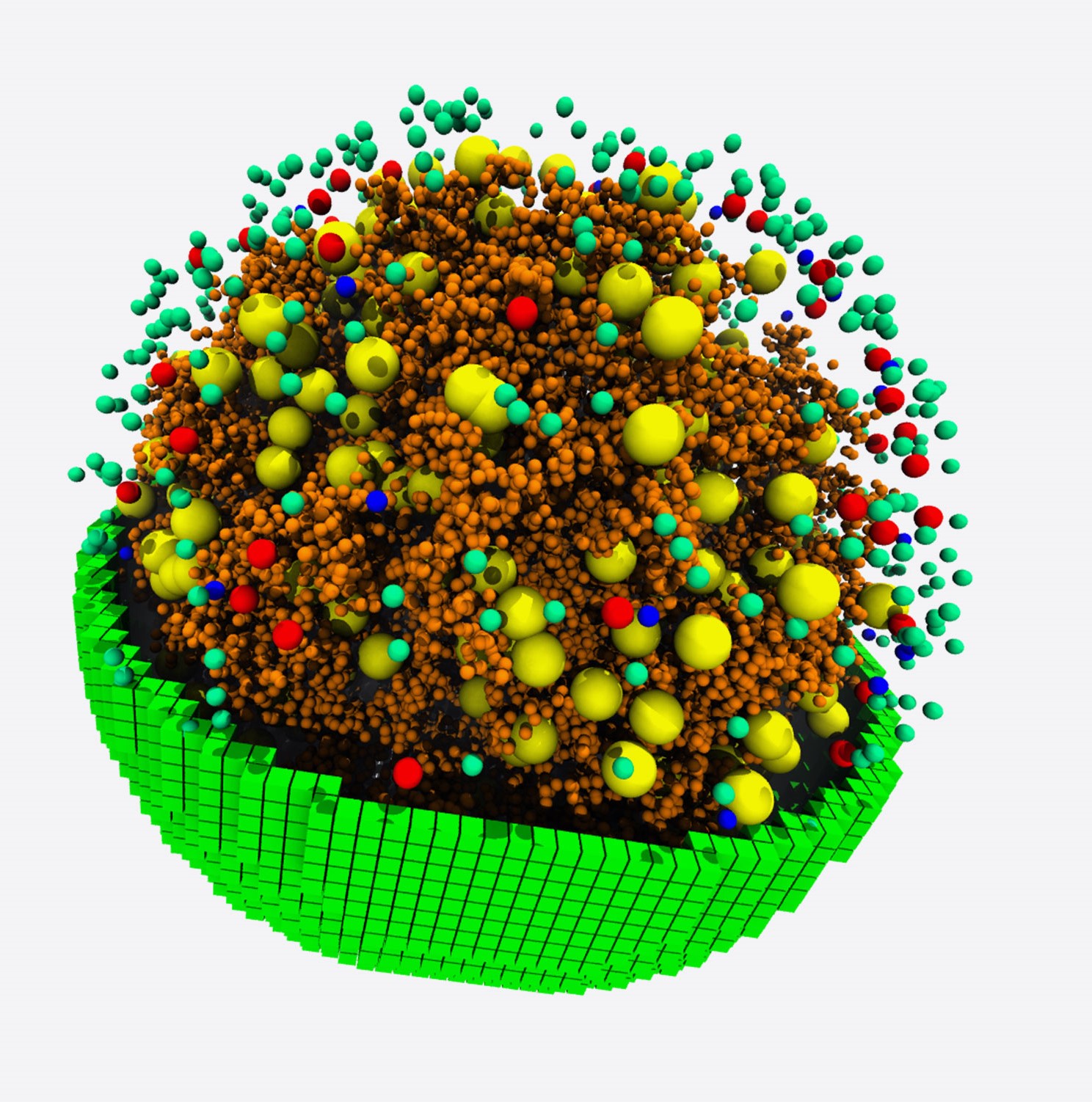Minimal Cell – Simulation Model Explained Its Behaviour
According to scientific reductionism, the best method to grasp the fundamental principles of cellular biology is to employ a minimal cell in which the roles of all genes and components are known.
Author:Suleman ShahReviewer:Han JuJul 28, 20228 Shares353 Views

According to scientific reductionism, the best method to grasp the fundamental principles of cellular biology is to employ a minimal cell in which the roles of all genes and components are known.
Molecular biology seeks to explain the fundamental processes of lifeusing physical and chemical rules.
A group of researchers led by Zane R. Thornburg from the University of Illinois, Urbana, USA, have created live cells with fewer genes than any other known naturally occurring cell. These cells were simpler to explain than naturally occurring cells wholly.
They used their minimal cell model to see whether a computer model can anticipate the collaborative activities of the minimum cell genes. Their finding was published in the journal "Cell."
What Is A Minimal Cell Model?
A thorough description of the cell's state requires information on its size, shape, components, internal reactions, and interactions with its environment, all of which change as time and cell development progresses.
The evolution of whole-cell models and how they differ from genome-scale metabolic models have been examined.
Because no single bacterium possesses a comprehensive set of parameters and omics data, constructing a whole-cell model depends on synthesizing data from other sources.
Common issues include creating reaction networks and obtaining kinetic parameters and metabolomics data to serve as beginning conditions.
A primary cell with as few genes and reactions as feasible for the cell to grow and divide would be an appropriate system for such a whole-cell model.
Syn3A is a genetically simple bacterial cell with just 493 genes on a single circular 543-kbp chromosome.
The genome and physical size of Syn3A are around one-tenth of those of the model bacterial organism E. coli.
It represents a once-in-a-lifetime chance to create a nearly complete whole-cell kinetic model.
3D Whole-Cell Simulations
These researchers built a spatial model with 7,765 distinct molecules and over 7,200 interactions, including binding reactions like RNAP binding to a gene start point.
The 3C-seq maps and proteomics of nucleoid-associated proteins (NAPs) imply that the DNA configurations are relaxed with no supercoiling, allowing the genes to be freely accessible.
The number of degradosomes breaking down mRNA, translating RNAP, and translating ribosomes is predicted via spatial simulations. Some rates, such as the DnaA filament formation rate, have been reported from single molecule studies.
Fast-growing E. coli has roughly 80% active ribosomes, but slow-growing E. coli has between 20% and 50% functional ribosomes, depending on the growth rate.
The average and median half-lives are consistent with Mycoplasma gallisepticum's 2-min average half-life.
DNA Replication And Surface Area Expansion Affect Cell Cycle Timing And Growth
The temporal dependency of DNA replication, chromosomal duplication, and doubling cell volume and surface area in Syn3A is investigated. In the well-stirred CME-ODE model, cells are simulated for whole cell cycles.
This model enables replication to start events on the daughter chromosomes once they split after the first replication cycle.
After the cell cycle, the DNA copy number increases to 2.8, indicating that one or both of the daughter chromosomes has partly finished another chromosome.
Cells that have undergone many replication processes may have chromosomal copy numbers as high as 3.8, suggesting that they have virtually duplicated both daughter chromosomes throughout the cell cycle.
Other bacteria have been demonstrated to replicate numerous times each cell cycle. In rich growth media, Syn3A has an empirically observed doubling time of 105 minutes.
A simulated doubling time was provided based on healthy cells, with counts adjusted to comparable levels in other bacterial species.
A "choke point" in the biosynthesis of PA has been discovered as the liponucleotide synthase cdsA/0304 catalyzing reaction DASYN that adds CDP to a phospholipid precursor (phosphatidic acid, PA).
Genes And Metabolism Are In Balance
Syn3A has few transcription/translation/transport regulatory proteins and must modify subsystem fluxes to expand. Syn3A generates two pepper glucose through enolase activity after glyolysis.
According to the kinetic model presented by the researchers, if the cell runs out of pep, ADP may be converted to ATP by ATP synthase to continue glycolysis or phosphorylate NDPs.
DNA replication rate is the most impacted genetic information process, averaging 75% of maximal.
Multiple replication events (green) cause greater RNA transcription, depleting NTPs and slowing transcription. Slow transcription allows nucleosides to be taken up and phosphorylated.
Minimal Cell's Time-Dependent ATP Expenses
The critical element is to accurately monitor every energy molecule utilized by active reactions in metabolic and genetic information processing.
tRNA charging is recorded as one ATP, while two phosphatebonds are usually counted. The number of proteins and related rates of metabolic processes increases as a cell expands, resulting in an overall increase in ATP generation and expense.
The metabolic processes have the highest cost in Syn3A, accounting for 75% of the overall metabolic cost.
The actual ATP costs of each transport process by tracking the fluxes through each reaction since each is simulated individually.
Transport processes are essential for a minimum cell, which is virtually dependent on nutrients from its surroundings.
Active transport costs almost twice as much as tRNA charging in termsof ATP (around 5,000:2,500 ATP per second), making it one of the most expensive energy expenses in the minimum cell.
While ATP synthase accounts for about 10% of total ATP expenses the bulk of the time, it may shift direction in response to low ATP levels in the cell.
Hybrid Well-Stirred And Spatial Simulations
The researchers compared mRNA counts for information-processing genes, nucleotide pools, protein distributions, and mRNA half-life distributions.
The spatial model has lower nucleotide concentrations than the well-stirred model, which can be attributed to two factors: first, more nucleoside transporters are being incorporated into mRNA, and second, the current spatial model does not include DNA replication, which begins around 10 minutes earlier in the cell cycle.
The somewhat higher counts obtained in the well-stirred simulations indicate that incomplete replication events occurred in a few cells during the first 20 minutes.
People Also Ask
How Many Genes Are Minimally Necessary To Sustain Life In A Minimal Cell?
Craig Venter Institute and Synthetic Genomics Inc. have been striving to develop a form of the bacterium Mycoplasma mycoides with the genetic instructions needed for life. According to him, at least 473 genes are required to maintain life in a lab.
What Is The Minimal Genome Concept?
Arcady Mushegian described a minimum genome in 1999 as a genome with the fewest genetic components required to generate a modern-type free-living cellular organism.
As a result, the idea of a minimal genome is inextricably linked to the definition of a minimum cell.
Which Cells Undergo Minimal Cell Division Are?
The two basic types of cells are simple non-nucleated prokaryotic cells and sophisticated nucleated eukaryotic cells.
Eukaryotic and prokaryotic cells do not divide similarly due to structural variations.
What Are The Components Of The Minimal Cell?
The minimal cell is a living cell with a small and sufficient number of components, as well as three main features:
- Some form of metabolism to provide the molecular building blocks and energy required for the cellular component synthesis
- Genetic replication from a template or equivalent information processing and transfer machinery
- A boundary (membrane) that separates the cell from its environment.
Conclusion
Current simulations predict a lower ratio of origins to termini formed in DNA replication than observed in qPCR experiments, which results from restricting the formation of replication forks on the daughter chromosomes to occur only after complete replication of the mother chromosome and from starting replication only after a full copy of the mother chromosome.
Each simulation has just one circular chromosome. The degradosome, RNAP, and ribosome complexes are now inactive, limiting the RDME-CME-ODE simulations.
Extending the simulations through numerous cell cycles would provide data on cell divisions, multiple initiations of DNA replication events, and DnaA filament creation.

Suleman Shah
Author
Suleman Shah is a researcher and freelance writer. As a researcher, he has worked with MNS University of Agriculture, Multan (Pakistan) and Texas A & M University (USA). He regularly writes science articles and blogs for science news website immersse.com and open access publishers OA Publishing London and Scientific Times. He loves to keep himself updated on scientific developments and convert these developments into everyday language to update the readers about the developments in the scientific era. His primary research focus is Plant sciences, and he contributed to this field by publishing his research in scientific journals and presenting his work at many Conferences.
Shah graduated from the University of Agriculture Faisalabad (Pakistan) and started his professional carrier with Jaffer Agro Services and later with the Agriculture Department of the Government of Pakistan. His research interest compelled and attracted him to proceed with his carrier in Plant sciences research. So, he started his Ph.D. in Soil Science at MNS University of Agriculture Multan (Pakistan). Later, he started working as a visiting scholar with Texas A&M University (USA).
Shah’s experience with big Open Excess publishers like Springers, Frontiers, MDPI, etc., testified to his belief in Open Access as a barrier-removing mechanism between researchers and the readers of their research. Shah believes that Open Access is revolutionizing the publication process and benefitting research in all fields.

Han Ju
Reviewer
Hello! I'm Han Ju, the heart behind World Wide Journals. My life is a unique tapestry woven from the threads of news, spirituality, and science, enriched by melodies from my guitar. Raised amidst tales of the ancient and the arcane, I developed a keen eye for the stories that truly matter. Through my work, I seek to bridge the seen with the unseen, marrying the rigor of science with the depth of spirituality.
Each article at World Wide Journals is a piece of this ongoing quest, blending analysis with personal reflection. Whether exploring quantum frontiers or strumming chords under the stars, my aim is to inspire and provoke thought, inviting you into a world where every discovery is a note in the grand symphony of existence.
Welcome aboard this journey of insight and exploration, where curiosity leads and music guides.
Latest Articles
Popular Articles

